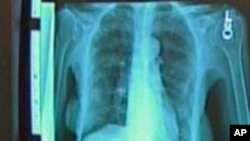Lung cancer can lie dormant for more than 20 years before turning deadly, helping explain why a disease that kills more than 1.5 million a year worldwide is so persistent and difficult to treat, scientists said on Thursday.
Two papers detailing the evolution of lung cancer reveal how after an initial disease-causing genetic fault - often due to smoking - tumor cells quietly develop numerous new mutations, making different parts of the same tumor genetically unique.
By the time patients are sick enough to be diagnosed with cancer, their tumors will have developed down multiple evolutionary pathways, making it extremely hard for any one targeted medicine to have an effect.
The findings show the pressing need to detect lung cancer before it has shape-shifted into multiple malignant clones.
"What we've not been able to understand before is why this is really the emperor of all cancers and one of the hardest diseases to treat," said Charles Swanton, an author on one of the papers from Cancer Research U.K.'s London Research Institute.
"Previously, we didn't know how heterogeneous these early-stage lung cancers were."
Lung cancer is the world's deadliest cancer, killing an estimated 4,300 people a day, according to the World Health Organization. Around 85 percent of patients have non-small cell lung cancer (NSCLC), the type analyzed in the two studies.
To get a clearer understanding of the disease, the two groups of British and American scientists looked at genetic variability in different regions of lung tumors removed during surgery and worked out how genetic faults had developed over time.
What they found was an extremely long latency period between early mutations and clinical symptoms, which finally appeared after new, additional faults triggered rapid disease growth.
In the case of some ex-smokers, the initial genetic faults that started their cancer dated back to the time they were smoking cigarettes two decades earlier. But these faults became less important over time and more recent mutations were caused by a new process controlled by a protein called APOBEC.
The research was published in the journal Science.
New Drugs
Ramaswamy Govindan of Washington University School of Medicine, who was not involved in the studies, said better understanding of such genetic alterations was key to developing more effective treatments.
There are also hopes for a new generation of immunotherapy drugs that boost the immune system's ability to detect and fight tumors, which could be particularly applicable to lung cancer.
"The large number of mutations may be the tumor's Achilles heel because every time a new mutation forms there is a chance for the immune system to recognize it," Swanton told Reuters.
Immunotherapy drugs from companies such as Bristol-Myers Squibb, Merck & Co., Roche and AstraZeneca are already undergoing tests in lung cancer, with data on Bristol's medicine Opdivo due later this year.
Apart from better drugs, a critical challenge is to find improved ways to detect lung cancer before it develops the multiple genetic faults that eventually trigger rapid tumor growth and spread.
Currently, doctors use computerized tomography (CT) to detect lung cancer, but by the time a nodule is big enough to be spotted it on a scan it may contain a billion genetically diverse cancer cells.
For the future, oncologists are pinning hopes on a new approach, known as liquid biopsy, that may be able to detect signs of cancer much earlier from DNA circulating in the blood.
The current prognosis for NSCLC is grim, with most patients diagnosed when the disease has already spread and only around 15 percent surviving for at least five years after that.





